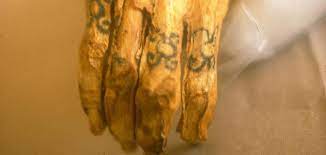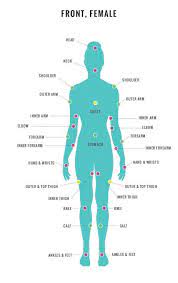
Tattooed remains have been discovered on over 49 mummies from various parts of the world, such as ancient Egypt, Greece, and Europe.
Otzi the Iceman
In 1991, two German hikers discovered Otzi, an ancient Iceman frozen for 5,300 years in Italy’s Italian Alps.
Clothing, tools, and weapons from the Iceman show evidence of his active life during the Copper Age. However, his tattooed body gives us more insight into early medicine than any other evidence available today.
Otzi adorned his body with 61 tattoos made up of lines and crosses. These tattoos were believed to have served as primitive acupuncture treatments to alleviate his chronic back pain.
Ancient Egypt
tattoos were discovered for the first time on two Ancient Egyptian mummies discovered in 1900 and now housed at the British Museum. These tattoos were located on their stomachs, thighs, and pelvises.
The tattoos were believed to have been used by these mummies to ask gods for protection during gestation and labor. They date back to 2000 BC and depict bowls used for purification rituals and the Egyptian god Bes.
Ancient Greece
In Ancient Greece during its Dark Ages, prisoners of war, criminals, and enslaved people often received tattoos displaying their offenses. This practice became widespread over time.
Herodotus recorded that during the sixth century BC, Greeks learned this method of punishment from Persians. tattoos were effective deterrents against escape and made people easily identifiable as enslaved people or prisoners.
Ancient Rome
Tattooing was an increasingly common practice in Ancient Rome and was used for various reasons. It was used to mark soldiers in the army, identify criminals, and distinguish gang members among enslaved people.
Public execution was also used to make enslaved people more visible to the general public and as punishment for escapees. The prevalence of tattooing in ancient Rome is evidenced by artwork and figurines from as far back as 4000-3500 BC.
Transoceanic Trade Routes
Tattooing has been practiced for millennia. Ancient Egyptian mummies and ancient Chinese and Northern European tribes used tattooing and body painting.
Tattoos were believed to have emerged in Polynesia, where ceremonies were held to initiate young men into chiefly roles and give them tattoos as part of a rite of passage that symbolized community status, respect, and honor.
Europe
Tattooing dates back thousands of years to Paleolithic cultures and is widely practiced by tribal Celts of Ireland, Scotland, and Wales. Archaeological evidence supports this claim.
During the Age of Discovery, Europeans were fascinated by images of tattooed Polynesian natives. tattoos were considered barbaric when Christianity arrived in Europe but gradually regained popularity with the resumption of transoceanic travel.

